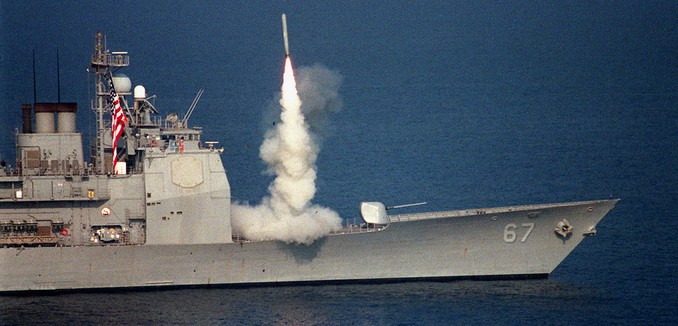The United States Navy retaliated for two recent attacks on U.S. ships by Iran-backed Houthi rebels in Yemen, firing cruise missiles at radar sites in rebel-held territories early Thursday.
All three targeted radar sites were destroyed at 4:00 AM local time by the USS Nitze, the Pentagon announced. Pentagon press secretary Peter Cook said in a statement that the strikes had been authorized by President Barack Obama based on the recommendations of Secretary of Defense Ashton Carter and Chairman of the Joint Chiefs of Staff Gen. Joseph Dunford.
“These limited self-defense strikes were conducted to protect our personnel, our ships, and our freedom of navigation in this important maritime passageway,” Pentagon Press Secretary Cook explained. “The United States will respond to any further threat to our ships and commercial traffic, as appropriate, and will continue to maintain our freedom of navigation in the Red Sea, the Bab al-Mandeb, and elsewhere around the world.”
The USS Mason was attacked by two Houthi missiles on Sunday; a Defense Department spokesman said that there were no injuries or damage to the ship, which was in international waters off the coast of Yemen. The Mason was again fired upon on Wednesday. “Those who threaten our forces should know that U.S. commanders retain the right to defend their ships, and we will respond to this threat at the appropriate time and in the appropriate manner,” Cook said after the second attack. According to the earlier statement the Mason had been attacked for “the second time in four days” while “conducting routine operations in international waters off the Red Sea coast of Yemen.”
Davis said at the time, “We assess the missiles were launched from Houthi-controlled territory in Yemen.” Davis emphasized that the U.S. is committed to ensuring free passage through the Red Sea strait, through which more than 4.7 million barrels of oil passed daily in 2014. “We will continue to take all necessary steps to ensure the safety of our ships and our service members,” he said,
The Mason was deployed to the Bab al-Mandab Strait, through which 4.7 million barrels of oil pass every day, after a United Arab Emirates ship was struck and severely damaged by Houthi rockets there last week. The weapons used in that attack were supplied by Iran, American officials told Fox News.
In August, Secretary of State John Kerry accused Iran of arming the Houthis with missiles and other sophisticated weapons. “The threat additionally posed by the shipment of missiles and other sophisticated weapons into Yemen from Iran extends well beyond Yemen,” he warned. “It is not a threat just to Saudi Arabia; it is a threat to the region, it is a threat to the United States, and it cannot continue.”
Iran has also stepped up its aggressive naval behavior in the Persian Gulf in recent months. In January, ten American sailors and their two boats were seized by naval forces belonging to Iran’s Islamic Revolutionary Guard Corps (IRGC), in violation of international law. Iran portrayed their capture as a victory against the U.S., releasing the sailors after claiming that Washington apologized for the incident. Supreme leader Ayatollah Ali Khamenei called the seizure of the Americans “God’s deed” and issued medals to the commanders involved, while the IRGC announced plans to build a statue to commemorate the incident.
In May, the IRGC’s deputy commander threatened to close the Gulf’s strategic Strait of Hormuz to the U.S. and its allies if they “threaten us,” adding: “Americans cannot make safe any part of the world.”
The U.S. Navy reported in July that there were nearly 300 encounters or “interactions” between American and Iranian naval vessels in the Persian Gulf in 2015. While most of the encounters were not considered to be harassment, the behavior of the Iranian navy was found to be less disciplined than that of other navies. Lt. Forrest Griggs, the operations officer of the USS New Orleans, explained that risks arise from the unpredictable behavior and uncertain intent of the Iranian vessels. “It’s very common for them to come up to within 300, 500 yards of us, and then they’ll turn, or parallel us and stop,” he told Fox.
Vice Adm. Kevin Donegan, the commander of the Navy’s Fifth Fleet, observed in November that Iran’s “malign behavior” at sea had not changed since the announcement of the nuclear deal four months earlier.
[Photo: Naval Surface Warriors / Flickr ]




